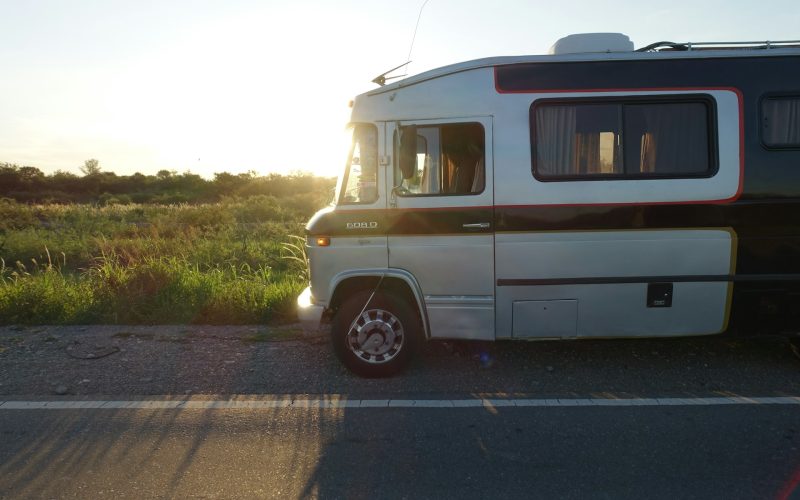There are more options than ever in the motorhome market, with a wide range of manufacturers represented in the UK. Given the variety of choices, it’s important to take your time, do thorough research, and carefully explore your options before making the final decision to purchase.
Types of Motorhomes
Motorhomes come in various shapes and sizes. Here are some of the main types:
Campervans and Panel Van Conversions
These vehicles are typically vans with minimal exterior modifications (usually just added windows), fitted inside for camping, which is why they’re also known as campervans. Most panel van conversions have limited headroom unless a high-top roof or an elevating roof is added for extra space and beds while on-site. Elevating roofs are beneficial as they allow the vehicle to fit under height barriers in car parks.
Coach Built
These start as a cab and chassis, to which a converter adds a caravan body. They come in two main styles: low profiles with a streamlined roof over the cab, or over cab models with enough space for a double bed above the cab.
A-Class
In these models, a chassis cowl (engine and chassis) serves as the base, with a full caravan body built on top, maximising interior space. A common feature is a full-size, drop-down double bed above the cab.
RV (Recreational Vehicles)
Larger and more expensive than most UK motorhomes, RVs typically offer home-like facilities in more spacious interiors. Many are imported from the US, though some European models are available.
Other Types
While most motorhomes fall into the above categories, there are also niche vehicles like car-derived motorhomes and demountables, where the caravan unit is attached to the back of a pickup for travel. Self-built motorhomes are also common. If the vehicle isn’t from a well-known converter, it should have an engineer’s report verifying that all gas and electrical installations meet safety standards.
Motorhome Manufacturers
Just as there is a wide selection of motorhomes, there is also a diverse array of motorhome converters. These range from large manufacturers across Europe and beyond, with extensive dealer networks, to small converters who may build to individual specifications and sell directly to the public.
Among the bigger brands, look out for names like Auto-Sleepers, Auto-Trail, Bailey, Elddis, Romahome, and the Swift Group (which includes Swift, Bessacarr, and Autocruise brands). There are also numerous European manufacturers such as Adria, Burstner, Chausson, Dethleffs, Laika, Hobby, Pilote, and Hymer. Note that some imported motorhomes may have the entrance door on the UK offside.
For more bespoke options, UK-based brands like Bilbo’s, Murvi, IH, Nu Venture, and Reimo are worth considering.
One important factor to consider is depreciation. While motorhomes generally retain their value well, standard models from mainstream makers are particularly likely to hold their value.
Cabs
Most motorhomes reveal their commercial vehicle origins in the cab area. Although power-assisted steering has been standard since the late 1990s, items like twin airbags and air conditioning have only recently become more common. If you want an upgraded stereo system, you’ll likely need to specify it as an option, though keep in mind that motorhomes tend to be noisier than modern cars.
The most popular motorhome base vehicles include the Fiat Ducato (also sold as the Peugeot Boxer), Volkswagen Transporter, Mercedes Sprinter, Ford Transit, and Renault’s Trafic and Master. Each comes with a variety of engine options, specifications, and payload capacities, so check these details carefully to ensure you know exactly what you’re getting.
You can request a test drive if you’re close to making a purchase decision. Remember, motorhomes are based on commercial vehicles and handle differently than cars, although handling improves with each new model. Larger motorhomes may have significant tail overhangs, which require extra care when driving on the road and manoeuvring in tight spaces.
Layouts and Facilities
As homes on wheels, motorhome interiors are a compromise between space and amenities. Consider the number of occupants, sleeping arrangements, and whether seats are designated for travel, as well as your priorities for kitchen and washroom facilities.
Smaller motorhomes are easier to park and store, while larger units offer more interior space, which is crucial if you plan to use your vehicle for extended periods.
Many motorhomes can accommodate an awning, providing additional living space. Some owners also enhance their vehicles’ versatility by adding bike racks, extra storage boxes, and more.
Think about when you’ll be using your motorhome. If you plan to use it extensively in winter, ensure the water tanks and plumbing can withstand cold temperatures. In warmer climates, consider adding air conditioning to the living quarters.
Most motorhomes come with a mains hook-up, allowing you to connect to a 230V electricity supply at UK campsites. This usually includes a charging system and a 12V leisure battery supply. Here are other factors to consider:
Sleeping Arrangements
Fixed beds are increasingly popular, especially bunk beds for children. Check the size and location of the beds, particularly overcab beds, where headroom can be limited, and access may be difficult. Ventilation and heating can also be issues in these areas.
Kitchen Facilities
Modern motorhomes may feature fridge/freezers, full cookers, microwaves, and hot and cold running water, or just a couple of gas rings. Consider the location of these items, as well as workspace and storage.
Washroom Facilities
Expect anything from plumbed-in, water-flushing toilets to large shower cubicles. Space is often limited, especially if the washroom also serves as extra storage or a drying room for wet clothes.
Lounging
Seating is a personal preference. If watching TV is important to you, think about where the TV will go and whether the seating is arranged accordingly.
Storage
The layout often determines how much storage space is available. Your storage needs may depend on the items you want to bring, such as bikes, fishing gear, outdoor chairs and tables, barbecues, and more. Floor plans with fixed beds often include large storage areas underneath, accessible from outside. “Garage” models, typically coachbuilt motorhomes, offer large, exterior-access storage spaces at the rear.
Winter Travel
If you plan to camp in colder weather, consider choosing a motorhome with an insulated water system to ensure it works on freezing mornings.
Top Tips
Timing
Prices tend to be highest just before Easter, when the touring season begins. They generally drop at the end of the season, but if you buy during the quieter months, factor in any potential winter storage costs.
Make a List
After setting your budget and choosing a preferred layout, list the features and fittings you want in your ideal motorhome, and decide which are essential.
Consider Hiring
Renting a motorhome first gives you a taste of the experience and helps you make an informed decision about the layout you want. The Club’s website lists motorhome hire companies throughout the UK.
Take Notes
Keep track of the exact makes and models you like, as it’s easy to forget details.
Check Outstanding Payments
If buying a second hand motorhome, check for any outstanding payments by contacting HPI (0113 222 2010, hpicheck.com).
Repair Costs
Look into the logistics and potential costs of repairs. While equipment like heaters and fridges are usually easy to source, replacement body panels and trim can be difficult to find, especially for discontinued models.
Travelling
If you’ve never driven a motorhome before, you may be pleasantly surprised by how easy it is, regardless of size. Benefits include a higher driving position for better views and large wing mirrors. Here are some other factors to consider:
Diesel or Petrol: Diesel is the preferred fuel for most motorhomes due to its economy, often with added performance from turbocharging. Fuel consumption varies depending on the vehicle and driving style. Engine size isn’t always the best indicator of suitability; compare power and torque instead.
While most motorhomes have manual transmission, automatic options are increasingly available.
There has been much discussion about electric and hybrid motorhomes and campervans, but range remains an issue due to the extra weight they carry. Currently, a fully electric motorhome can be expected to have a real-world range of only around 100 miles. Additionally, most public EV charge points are too small for typical vans, though campervans may fit. It’s worth checking before you buy.
Driving in Cities
If you plan to take your motorhome into cities, check whether there are low emission zones (LEZ) or clean air zones (CAZ) in place.
London established its LEZ in 2008, and since 2021, a growing number of CAZ have been introduced across the UK, with varying restrictions. Some zones apply only to goods vehicles and public transport, while others cover all vehicles. The Euro emission standard of your vehicle will determine whether you’re subject to a surcharge when driving in these zones, identified by automatic number plate recognition (ANPR). The .gov.uk website offers a numberplate checking tool. We provide more information in our travel planning section.
Motorhome Safety and the Law
Several key legal aspects could impact your choice of motorhome:
Driving Licence
Check your driving licence to ensure it allows you to drive your motorhome, as those over 3,500kg require a C1 licence.
Seat Belts
Some new motorhomes may have more sleeping berths than seat belts. Since 20 October 2007, seat belts are not permitted on side-facing seats due to the risk of injury in a crash. Passengers should always wear seat belts for safety, and in some cases, it could be illegal to travel without them.
Payload
As the owner, you’re legally responsible for ensuring your vehicle isn’t overloaded beyond its gross weight or axle limit. Keep in mind that your available payload decreases as fitted extras are added, so check that there’s enough payload for the number of people and gear you plan to carry.
Speed Limits
If your motorhome’s unladen weight is less than 3,050kg, normal car speed limits apply, unless you’re towing. For vehicles over this weight or with more than nine seats, the speed limit is 50mph on single carriageways and 60mph on dual carriageways, though it remains 70mph on motorways.
Loading Your Motorhome
It’s tempting to think you can load as much as you want into your motorhome since it’s based on a large van, but this isn’t always the case.
Your motorhome will have a set user payload, the amount of extra gear you can carry, which depends on its construction. In some cases, this may be limited by the chassis it’s built on. In others, it may be artificially restricted so those with specific driving licences can drive it, or for other reasons. If necessary, you can ask your supplier to uprate its classification to allow for a larger payload.
It’s also important to consider how you position the payload in your motorhome. Each axle has a loading limit, which you must not exceed. Generally, most of the weight from the engine, fuel, and passengers will be over the front axle, so your luggage and other loads should be positioned over the rear axle.
To ensure your motorhome is correctly loaded, pack it and take it to a weighbridge to check the loads on each axle.









